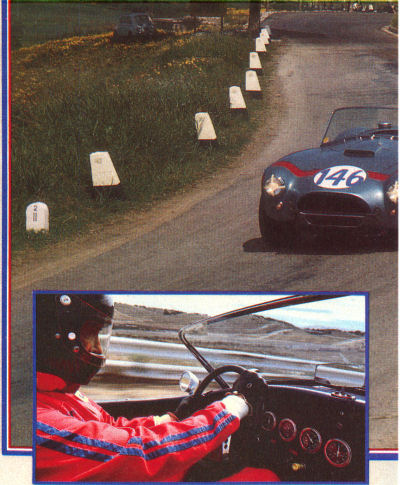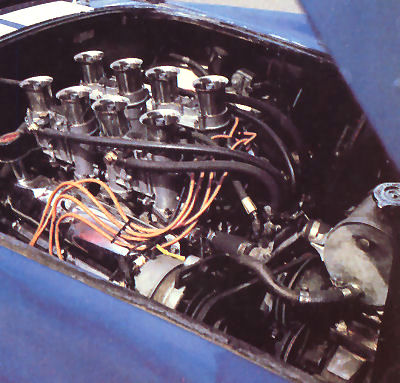Road and Track - December 1979SalonThe
man behind it all was Texan Carroll
Shelby.
who had a long and successful career as a race driver behind him and
had only quit because of a heart problem. Before his retirement. Shelby
had tried to interest General Motors in a competition sports car, hut
GM was interested only in Corvettes. so Shelby directed his immense
charm and powers of persuasion in Ford's direction, with considerable
success. What he actually did was to bring together Ford's engines (and
Ford's money) with AC Cars Ltd in England, the builders of the AC
Bristol. In the best tradition of the British
specialist car
builder, AC Cars is nothing much more than a fabricating shop in the
main street of a sleepy little English village called Thames Ditton. At
the time, the Bristol Aeroplane Company had just stopped production of
the engine used in the AC Bristol and Shelby felt that a small-block
Ford V-8 would be ideal. He caused a modified but engineless AC to be
flown to Los Angeles, where he and Dean Moon had it running within
eight hours. The Cobra was born and Carroll Shelby was on his way.
| 
The true ancestry of
the Cobra goes hack as far as 1950, when a
relatively unknown designer named John Tojeiro decided to offer a
racing sports car chassis, which would accept almost any of the
available competition engines of the time. Working by himself, Tojeiro
built what was eventually to become the basic layout for the Cobra. One
of his first customers was named Cliff Davis. | Davis
ordered his car with a tuned version of the 6-cylinder Bristol engine.
When it came time to body the car, Tojeiro was in a hurry and also
somewhat lacking in resources, so he looked around to see what other
people were doing. Showing excellent taste, he settled on the beautiful
little barchetta body with which Carrozzeria Touring had clothed the
Ferrari 166 Mille Miglia. and built a fair copy of it. although he
simplified it along the way to suit the available amounts of time and
resources. The TojeiroBristol became a famous and successful car and.
thanks to Touring, it had an ageless appearance. At
the time, AC
-Cars was having some bodies built by a company called Buckland Body
Works Ltd, which was close to Tojeiro's shop, and Derek Hurlock. who is
now the boss of AC, heard about Tojeiro while on a visit to Buckland. A
deal was made and Tojeiro cooperated in adapting his design for road
use and the car appeared as an AC, first with AC's own 6-cylinder
engine and later with the Bristol. Because it was
built in a
fabricating shop. the AC Cobra benefited enormously from its extreme
simplicity. The chassis consisted of two 3.0-in. diameters steel tubes
connected by crossmembers in ladder-style with spring towers at each
end. Body framing and support brackets were welded to the main tubes
and the bodies were of aluminum. Front and rear suspension was by
transverse leaf springs and lower A-arms, and disc brakes were used all
around. In the early stages of production, a number of modifications
were made from time to time so that there was a certain amount of
variation between the cars. The first contract was
for 100 cars,
which were delivered between December 1962 and April 1963, and the
first 75 of these were fitted with Ford's 260-cu-in. engine. However,
Ford starting to build a 289-cu-in. engine which was absolutely ideal
for Shelby's purpose. Ford had been doing extensive research into
methods of thin wall casting, so the new engine was light. It had a
rather extreme bore to stroke ratio of 4.00 in. to 2.87 in., which
also helped to reduce the weight as well as keep down the piston speed
and permit big valves to be used. and it was offered in a
high-performance version giving 271 bhp. It was one of the best engines
ever built.
|

| The
engine in Mike Shoen's car was, of course, tweaked by Shelby's men. but
not excessively so. Shelby's sworn intention was to win with a team of
Cobras the series of classic races which counted toward the
international manufacturer's championship. a' to put it more succinctly
in Carroll's words, "To git Ferrari's ass." These races included Le
Mans, the Targa Florio. Sebring and other long-distance events, so
stamina was just as important as speed. Fortunately, the engines were
extremely rugged just as they came out of the box, so the stock
crankshafts, rods and pistons were retained after being balanced.
The
two engine men were Cecil Bowman and Jack Hoare and their primary job
was very careful hand assembly to fine limits, and considerable
attention to the gas flow through the heads. Four twin-choke, downdraft
Webers were used and the diameter of both the intake and exhaust valves
was increased by I /16 in. To take advantage of the larger valves, the
ports were opened up and finally the complete combustion chambers were
polished. Various compression ratios were used, but 11.6:1 was about
normal. With these and other modifications, such as different valve
overlap and ignition timing, the engine put out between 340 and 370
bhp. This output by no means stretched the engines anywhere near the
limit, and Phil Hill recalls them as being very reliable as were the
whole cars. Furthermore, according to Phil. the torque characteristics
of the engines were such that you didn't have to bother very much where
you were on the power curve.
|
|

